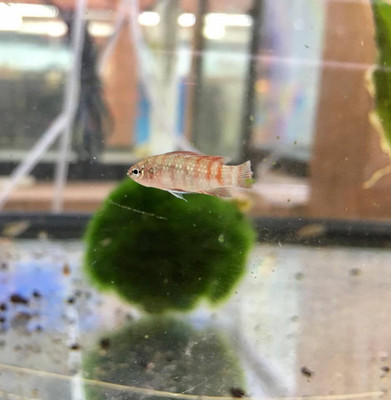Scarlet Badis (Dario dario)
Posted by Max Gandara on on 4th May 2025
Scarlet Badis (Dario dario): The Tiny Jewel of Freshwater Aquariums
In the world of freshwater nano fish, few species capture attention like the Scarlet Badis (Dario dario). With its vibrant red-and-blue striping and shy, deliberate personality, this tiny fish is a favorite among aquarists looking to create a peaceful, visually captivating tank. Despite its small size, the Scarlet Badis brings a bold presence to any aquascape.
Origins and Natural Habitat
The Scarlet Badis is native to the shallow, slow-moving streams and rivers of West Bengal and Assam in India, often found in heavily vegetated waters with sandy or muddy bottoms. These environments are typically warm, soft, and slightly acidic, which is key to understanding their care in captivity.
Appearance
What they lack in size — with males growing to just 0.8 inches (2 cm) — Scarlet Badis make up for in dazzling color. Males sport vertical red and blue stripes with iridescent fins, while females are smaller and drabber, usually light grey or beige.
Key Features:
-
One of the smallest freshwater fish in the hobby
-
Males are vibrantly colored; females are more muted
-
Peaceful but territorial toward other males
Tank Setup and Requirements
Because of their size and temperament, Scarlet Badis thrive in nano tanks and species-specific setups.
Ideal Tank Conditions:
-
Tank Size: Minimum 5–10 gallons (more if keeping multiple males)
-
Water Temperature: 72°F to 79°F (22°C to 26°C)
-
pH Level: 6.5 to 7.5
-
Water Hardness: Soft to moderately hard
-
Aquascape: Dense vegetation, leaf litter, driftwood, hiding places, low flow
Scarlet Badis do not appreciate strong currents or bright lighting. A heavily planted tank with hiding spots will help reduce stress and encourage more natural behavior.
Behavior and Tankmates
Scarlet Badis are shy, slow-moving, and territorial, particularly the males. They are best kept in species-only tanks or with other peaceful, non-aggressive nano fish that won’t outcompete them for food.
Compatible Tankmates:
-
Pygmy Corydoras
-
Small Rasboras (e.g., Chili Rasboras)
-
Ember Tetras
-
Shrimp (but may eat small ones)
-
Otocinclus catfish
Avoid housing them with fast or aggressive feeders like guppies, barbs, or bettas.
Diet and Feeding
One of the biggest challenges of keeping Scarlet Badis is feeding. They are micropredators and often refuse dry food. Instead, they prefer live or frozen fare.
Recommended Diet:
-
Live or frozen daphnia
-
Baby brine shrimp
-
Bloodworms (chopped)
-
Microworms or grindal worms
Some individuals may accept high-quality frozen foods over time, but live foods often yield the best health and coloration.
Breeding
Scarlet Badis are relatively easy to breed with the right conditions, but success depends on having a dedicated breeding tank.
Breeding Tips:
-
Males court females with vibrant color displays and body flaring
-
Provide fine-leaved plants or caves for spawning
-
The male guards the eggs until hatching (about 2–3 days)
-
Fry are tiny and need infusoria or powdered fry food initially
Challenges and Considerations
-
Feeding difficulties are the most common hurdle
-
Males are territorial; avoid multiple males in small tanks
-
Need stable, clean water to thrive
-
Best kept in well-established, cycled aquariums
Final Thoughts
The Scarlet Badis is a true gem in the freshwater world — delicate, vivid, and utterly fascinating. While not the easiest fish to care for, their unique behaviors and brilliant appearance make them a rewarding project for dedicated aquarists. With proper feeding and a tranquil environment, Dario dario can flourish and even breed, offering an intimate glimpse into the secret life of one of the smallest predators in the hobby.

